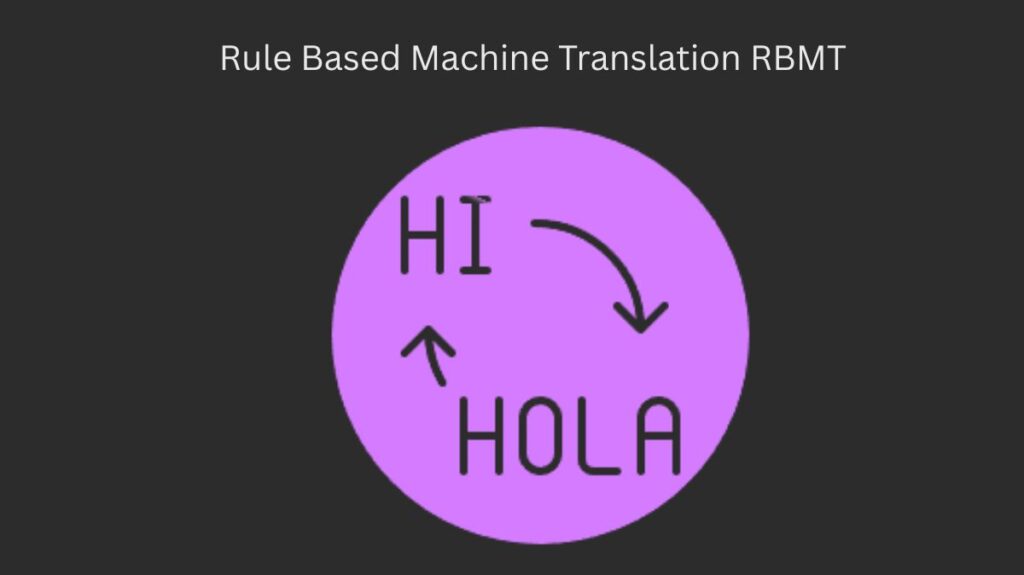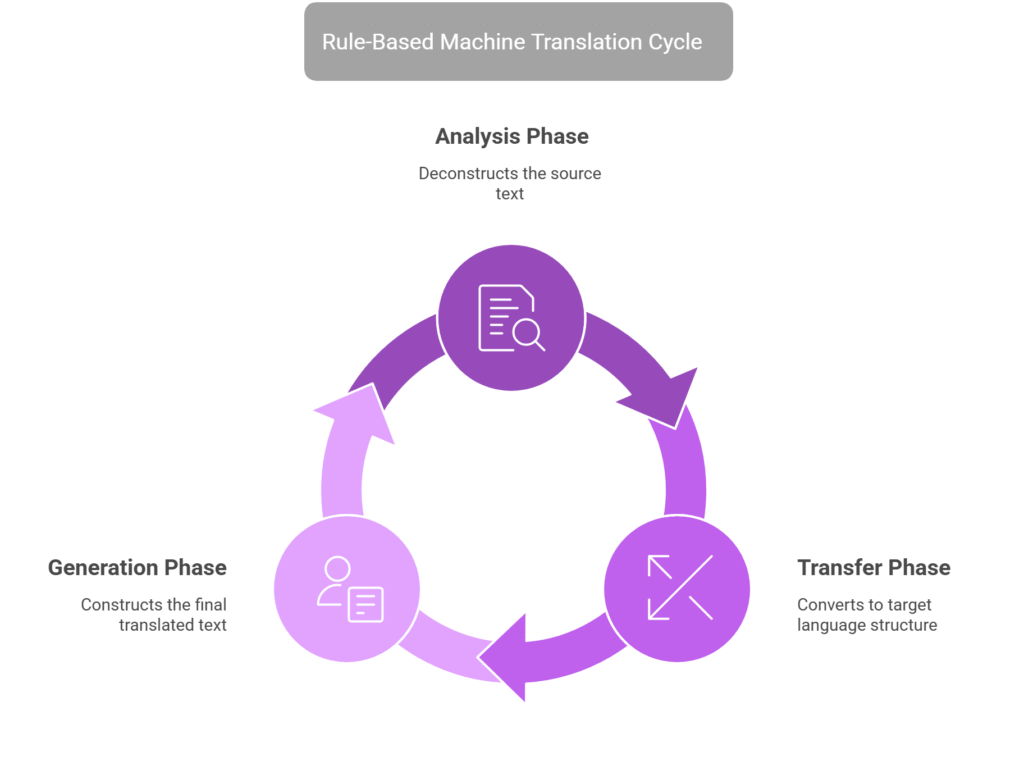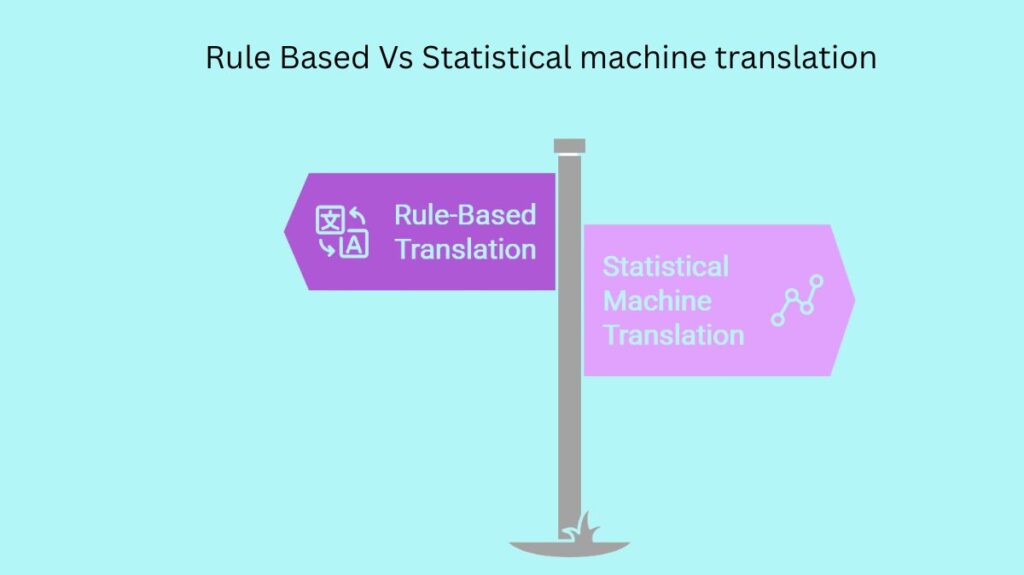What is Rule Based Machine Translation RBMT?

RBMT emphasises source and target language grammar, syntax, and semantics. This approach offers a high degree of control and predictability by guaranteeing that the translations closely follow the established linguistic norms.
Types of RBMT
Rule-Based Machine Translation systems come in three primary varieties, each with a unique method for dealing with language translation rules:
Learn more on The History Of Machine Translation MT And How Does It Work?
- Systems for Direct RBMT Word-by-word translation from the source language to the target language is accomplished via direct systems. They frequently use bilingual dictionaries and basic grammar. These systems work well in settings where speed is more important than precise precision.
- Systems for Transfer RBMT By converting phrases into an intermediate representation before translating them into the target language, transfer systems are able to carry out more complex analysis. Three steps are involved in this process: generation, transfer, and analysis.
- Multilingual RBMT Frameworks Before translating text, interlingual systems transform it into an abstract, language-neutral representation called an interlingua. From the interlingua, the target language is translated. These systems are incredibly adaptable and capable of handling a large number of languages with various grammatical patterns.
Internal Mechanisms of Rule-Based Machine Translation Systems
Comprehending the Workflow
Machine Based on Rules Translation offers a methodical and trustworthy approach to translation. These algorithms make sure that every sentence complies with the grammatical nuances of both the source and target languages by closely following linguistic norms.

The following detailed explanation of how RBMT systems operate shows how they can improve enterprises’ ability to communicate globally:
Analysis Phase
The machine checks source language grammar first. Syntactic analysis parses the sentence using grammar, while morphological analysis identifies word elements.
Transfer Phase
Then, an intermediate representation of the source language’s acknowledged grammatical structures is constructed. This intermediate structure preserves context and meaning during translation by connecting the source and destination languages.
Generation Phase
Finally, the system generates target-language translations. To achieve an accurate and grammatically correct translation, apply the target language’s rules to the intermediate structure.
Rule Based Machine Translation Example
Let’s examine a real-world example of how to use the RBMT system to translate an English statement into Hindi:
“The girl eats an apple” is the source sentence.
Analysis Phase
- Morphological Analysis: The system classifies words grammatically:
- The article “the” (determiner).
- “girl” as a noun.
- The verb “eats.”
- “an” as a determiner or article.
- The noun “apple”
- Syntax Analysis The algorithm generates the sentence form [Article] [Noun], a standard English SVO pattern. [Verb] [Article] [Noun].
Transfer Phase
In order to map the English sentence structure onto the Hindi sentence structure, the RBMT system transforms it into an intermediate representation. This includes:
- Translating grammatical concepts from English to Hindi.
- Rearranging words to match Hindi SOV phrases.
- Assuring gender, number, and case accuracy.
Generation Phase
- “लड़की एक सेब खाती है” is system output.
Case, gender, and verb conjugation in Hindi.
- Translation for “The girl”: “लड़की.”
- Translation of “eats”: “खाती है।.”
- Translated “an apple” is “एक सेब.”
Learn more on Advantages And Disadvantages Of Machine Translation MT
Rule-Based Machine Translation Advantages and Disadvantages
Multilingual companies must balance RBMT’s merits and downsides. For many sectors, successful multinational operations may depend on an understanding of the advantages and disadvantages of RBMT.
Rule-Based Machine Translation’s Advantages
- High Accuracy in Certain Domains: RBMT systems perform exceptionally well in specialist domains like the legal, medical, and technical sectors where language usage and terminology are uniform. The exact guidelines and comprehensive dictionaries guarantee extremely accurate and contextually relevant translations.
- Consistency and Predictability: RBMT’s deterministic structure guarantees consistent translations. The system consistently generates the same output for the same input once the rules are established, which is essential for preserving consistency in extensive translation projects.
- Control Over Linguistic Output: The translation output is mostly within the control of businesses. Users can tailor translations to match particular needs by improving dictionaries and rules, guaranteeing that the translated material precisely matches their brand voice and terminology.
- No Need for Big Corpora: RBMT does not require a lot of bilingual text material, in contrast to Statistical Machine Translation (SMT) and Neural Machine Translation (NMT). For languages with specialist terminologies or limited digital resources, this makes it especially helpful.
Rule-Based Machine Translation Disadvantages
- Expensive development and upkeep: RBMT system development and maintenance require a lot of resources. The creation and updating of the dictionaries and rules necessitates a high level of linguistic competence, which is expensive in both time and money.
- Complexity and Scalability Issues: Updating the RBMT system gets more difficult as new terms and languages appear. Overseeing the interactions between multiple rules might result in a complex system that is challenging to scale and modify rapidly.
- Machine-like Translation: RBMT occasionally generates translations that seem stiff and artificial. The text may become less readable and fluent while maintaining sense, necessitating further post-editing to make it sound more human.
- Limited Adaptability: Languages with significant idiomatic expressions or extremely flexible grammatical rules are difficult for RBMT systems to understand. Without significant manual rule set adjustments, they might not adjust effectively to new domains.
Rule Based Vs Statistical machine translation

Rule-Based Machine Translation (RBMT)
- RBMT translates text using dictionaries and pre-established language rules. It examines the source and destination languages’ grammar and structure. It does not require a lot of information. Rather, it uses lists of words and rules that have been developed by experts.
- Accuracy: Extremely accurate in certain domains where the language is clear and consistent, such as legal, medical, or technical text. It might, however, have trouble understanding colloquial or informal language.
- The cost of development is high. Language experts must put in a lot of effort to develop and update rules for every pair of languages.
- Use Cases: Ideal for translating specialised papers like medical records or contracts where accuracy is crucial.
Statistical machine translation(SMT)
- SMT, or statistical machine translation, makes use of statistical models that have been trained on substantial corpora of translated texts. It uses data patterns to choose the most likely translation. Requires a lot of multilingual text (parallel corpora) in order to function properly.
- Accuracy: Generally accurate and fluid, particularly when discussing general subjects and daily language. If there is insufficient training data for a particular field, performance may suffer.
- Cost of Development: Moderate. It is dependent upon the data’s accessibility. Systems can be trained without extensive linguistic knowledge once data is provided, but they require processing power.
- Use Cases: Ideal for real-time translation and general content on websites, chat rooms, and customer support.
Learn more on Grammar Correction NLP & What Is Question Answering In NLP
